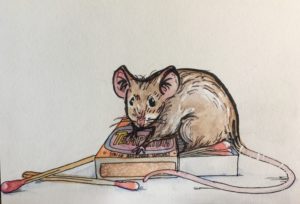 In the late 1950s, while American families blew up in size and the seeds of the turbulent ‘60s sprouted and began to grow, my parents went through what I call their Mini-Mammalian Period, a microcosmic span of time reminiscent of the mid-Jurassic. It was characterized by an unbridled proliferation of undersized pets, beginning with the patriarch Templeton.
In the late 1950s, while American families blew up in size and the seeds of the turbulent ‘60s sprouted and began to grow, my parents went through what I call their Mini-Mammalian Period, a microcosmic span of time reminiscent of the mid-Jurassic. It was characterized by an unbridled proliferation of undersized pets, beginning with the patriarch Templeton.
Templeton was, in my father’s words, “popular with the ladies, the best mouse we ever had.” He was named, of course, for the grouchy barn rat in E. B. White’s Charlotte’s Web, a caustic yet comic character. The Templeton of our house did little but sleep in the corner of his cage by day and impregnate the mouse damsels by night (or day). His offspring were legion and our apartment was small, which led to a kind of territorial war between homo sapiens and rodents. If not for my mother’s instinct to protect her own young, the rodents might have prevailed.
To some, her methods were ruthless, but this was New York City where tales were told of pythons and baby alligators, cute little pet store exotics, growing to adult size in the sewer systems whither they’d arrived by way of the WC. My mother was considerate. She took us to the bus stop and waved us off, then went home and wreaked havoc with the gene pool. We only knew that every few mornings before breakfast there seemed to be a new batch of little pink erasers in the mouse cage, and by the time we got home from school there were none.
Templeton outlasted many wives and courtesans—all of them in fact. He was more than three years old—practically of Old Testament age in rodent years—when we found him one morning sleeping off a long, busy night, or so we thought. We buried him in a Diamond matchbox in a shallow grave in Central Park, behind the 76th Street playground.
After Templeton left us, our family increased in size. It was almost as if the Templetonian influence overcame the homo sapiens and in a wild flurry of reproduction two more mouselets, my brother and sister, joined our ranks. And along with them came, in short order, a raccoon and skunk. We had moved out of the Mini- and into the Midsize-Mammalian Period, thanks to my father who’d discovered an unusual pet shop on Lexington Avenue, tucked between a pizza place and a store that sold sweaters from Ecuador. The shop was narrow and dimly lit, probably illegal, and smelled of cat urine. Along with puppies and kittens, hamsters and budgies, the pets sold were wild animals—wild, but not exotic. They came, mostly, from neighboring New Jersey.
My father had it in his head that a new pet for the older kids would eliminate sibling jealousy and distract us from torturing the newborns. It hadn’t occurred to us to torture the newborns—we thought they were cute and didn’t mind sharing an already small New York apartment with them. But the raccoon and skunk were problematic. The raccoon, Mr. Peepers, routinely used his very human hands to open all the bottles in the medicine cabinet. He was fond of pink and loved to paint the walls with Pepto-Bismol. The skunk, whose name I don’t remember (it might have been Petunia), had been only partially de-scented and loved to dig around in our clothes closets and drawers, leaving a wild flavor everywhere which led to embarrassing moments at school. But after a year or so, the more unusual Midsize-Mammalians moved on—the raccoon to join Captain Kangaroo on television and the skunk to live at the Children’s Zoo—and we became a normal family, a family of terriers.
Last June, a week before my mother’s memorial service, my older sister and I took upon ourselves the task of clearing out the house Mom had lived in every summer of her life. We cleaned and sorted for several days. I noticed neither of us approached the clothes closet but worked around it, finding other worthy tasks, as if testing our approach to a part of the house that was intensely personal and required an expertise and a willingness to cry openly that we did not yet have. That closet was the last part of the journey; the rest was practice.
We arrived there, finally, and set to work. My sister placed my mother’s blouses and jackets and pants and shoes in black plastic garbage bags and I pulled the more impersonal things down from the shelves—canvas duffel bags, nautical charts of the Maine coast, boxes of Depends and a few rolled up rugs. From inside one of the rugs came a sound that startled me, a familiar sound. My sister looked up from her garbage bags, nodding her head. It was, of course, the squeak of newborn mice. We knew it well. It took us all the way back to Templeton, back sixty years.
There were two of them, not-so-little erasers in a mousy nest made from bits of rug and lined with pieces of my mother’s fleecy slippers. They had a light coat of hair and their eyes were open. I thought of what my mother would do with them and decided against it, then set them outside under a tree and knew the late spring temperatures of coastal Maine would give them a natural death by morning.
The smaller of the two died overnight and I buried the little body under the moss. Mouse 2, as I called him then, held on through a second night, then a third, and at that point I couldn’t bear his unassisted aliveness anymore and I brought him in and named him Stuart. I put him in a box full of cotton and fed him with a dropper and as the hours and days went by he got smaller and skinnier and my sister, among others, gave me looks of exasperation and pity. As my mother’s memorial service got closer and Stuart diminished, I knew what I was up to and it was alright. The little mouse died on the morning of the day we buried Mom’s ashes, and I was relieved; I was happy to put him to rest. He died on a comfortable bed of cotton with a little milk on his chin, and his presence had comforted me. It had taken me back to a time I had long since forgotten, a time when we were a young family with all the days in the world ahead of us, the time of Templeton.

